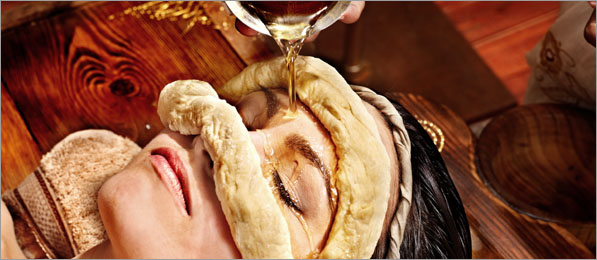Departments

The science of Ayurveda is divided into eight different categories for demarcating the Ayurveda treatment of one ailment from another. These eight categories are Kaaya Chikitsaa, Graha Chikitsa, Shaalakya Tantra, Agada Tantra, Rasayana Tantra, Vajeekarana Chikitsaa, Shalya Tantra and Baala Chikitsa or Kaumara Bhritya.
The meaning of Kaya is Agni (digestive fire) and the Ayurveda treatment based on Agni is called Kaya Chikitsa (chikitsa means treatment). This is a general treatment, which encompasses all other branches. Agni is responsible for the conversion of food into body elements. Kaya Chikitsa deals with the correction of ‘agni’, which in turn helps in the restoration of health.
Kaya Chikitsa deals with the diagnosis and treatment of a variety of general diseases such as skin disorders, diabetes, tuberculosis, rheumatoid, etc. Charaka Samhita is the most important scripture of Kaya Chikitsa. It discusses the basic principles of Ayurveda treatment, various types of therapies and purification or detoxification methods.
Panchakarma is Ayurveda’s primary purification and detoxification treatment. It helps in the balancing of doshas (bioelements) in the body. According to Ayurveda, disease is the result of imbalance of doshas. When a particular dosha is in a large quantity, the best way to get cured is by expelling the vitiated dosha.
Panchakrama means five (pancha) procedures (karmas). They are Vamana (Emesis), Virechana (Purgation), Niroohavasti (Decoction enema), Nasya (Instillation of medicine through nostrils) and Anuvasanavasti (Oil enema). It can be performed not only by a patient for balancing the doshas, but even healthy persons for maintaining their health.
The therapy comprises of five basic types of advanced Ayurveda treatment for the evacuation of vitiated ‘Dosha’ (toxic materials) from the body. It also includes many subtypes, different types of herbal massages, fomentations such as steam, external oil treatments, Basti (medicated enemas), etc.
Shalakya Tantra, a branch of Ashtang Ayurveda, deals with diagnosis, Ayurveda treatment and prevention of all diseases occurring above the neck such as eyes, nose, ear, mouth and head. Nimi (King of Videha) was the father of Shalakya Tantra. He acquired the knowledge of this science from Lord Surya (Sun). It deals with Ayurveda treatment for diseases of head, ear, nose, eye and throat including their anatomy, physiology and pathology.
The branches of Shalakya Tantra include Nethrachikitsa (Ophthalmology), Karnachikitsa (Otology), Nasachikitsa (Rhinology), Mukharogachikitsa (Oral Hygiene, Dentistry and Laryngology), and Shirorogachikitsa (diseases of the Cranium). This science uses many ‘Shalaka’ (meaning probe), which justifies the name Shalakya Tantra.
Shalakya Tantra is also known as Urdhwangchikitsa in South India.
Kaumara Bhritya or Baala Chikitsa means nourishing, supporting and maintaining the health of children. It is a branch of Ayurveda, which deals with prenatal and postnatal care of the baby and the mother. It also deals with other related health topics such as wet nurse, disorders of breast milk and their Ayurveda treatment, children diseases caused by consumption of vitiated breast milk and affliction of Grahas and their treatment. The discipline of Kaumarabhritya finds a parallel in the modern discipline of paediatrics.
Surgery belongs to the Dhanvantri School. The name of the sage-physician, Susruta is synonymous with surgery. The original text of Susruta discusses in detail an exhaustive range of surgical methods, which includes dealing with various types of tumours, internal and external injuries, bone fractures, complications during pregnancy and delivery, and obstruction in intestinal loop.
Charaka, the best-known physician of Ayurvedic medicine, also recommended ‘Shalya Tantra’ for the Ayurveda treatment of certain diseases, which require immediate attention such as haemorrhoids. Shalya Tantra was popular because it gave fast relief as compared to the slow process of recovery from medicines or herbs.
Swasthavritta is a science of Health, which advocates the theory and practice of maintaining public and private health. Swasthavritta in ayurveda means maintenance of the health of an individual. The ayurvedic lifestyle followed during the yesteryears and the vitality of the people living then is a testimony to the beneficial effects of following a healthy regimen.
The rules and regulations in respect to proper well-being of the body are two-fold:
- Consumption of diet and
- Observance of personal, moral, seasonal and spiritual conduct
Swasthavritta emphasizes on following a proper daily regimen and seasonal regimens. Daily regimen deals with instructions for day-to-day living such as morning routine, basic cleanliness, natural urges, evening routine, etc. The seasonal changes and climatic changes also have a particularly important effect on the health. Hence, ayurveda recommends a season specific regimen. These activities help us to cope up with the changes in the environment. Swasthavritta also includes Sadvritta that can be classified into five types, i.e. good mental conduct, good social conduct, good religious conduct, good personal conduct and good moral conduct.
‘Prasuti Tantra’ deals with pregnancy, labour and puerperium (the period of about six weeks after childbirth during which the mother’s reproductive organs return to their original non-pregnant condition). It finds its parallel in the modern discipline of obstetrics and gynaecology. Prasuti Tantra is concerned with the methods of achieving knowledge about reproductive dhatu (tissue), measures for maintaining healthy pregnancy, factors injurious to pregnancy, abortion and its management, factors responsible for the inhibition of foetal growth and its care, dietary and other care of a pregnant woman, child delivery and post natal care. ‘Stree Roga’ deals with identification, diagnosis, pathology and Ayurveda treatment of various diseases related to women.

